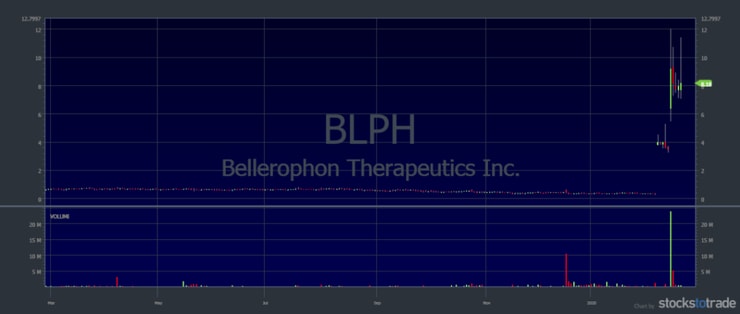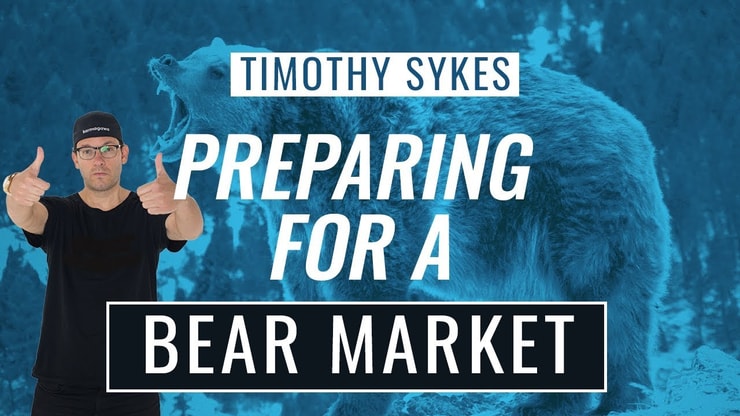Think predicting the market is easy? Think again.
Recently, the market hit all-time highs. A lot of people ask me, “where does it go from here?”
I don’t know. I never know. Nobody does.
I don’t try to predict anything. It’s too dangerous. So if your strategy is banking on what you think will happen, you need to shift your trading mindset.
I get it. It’s human nature to want to predict the future. You want to prepare for what’s coming. But predicting isn’t preparing…
You need to learn to react to the market.
Trading’s about discipline and preparation. If you’re really prepared … if you study the past … if you work to build your knowledge account … it doesn’t matter if the markets are up or down…
If you’re new to low-priced stocks, here’s my completely free guide to penny stocks. Start studying now.
Table of Contents
Did We See the Top of the Market?
To start off 2020, some of the largest companies in the market were solidly trending up on their way to all-time highs — like Amazon.com, Inc. (NASDAQ: AMZN), Facebook, Inc. (NASDAQ: FB), and Apple Inc. (NASDAQ: AAPL). The S&P 500 and the Nasdaq also hit all-time highs in February.
But there’s been a panic in the markets this week due to the coronavirus. On February 24, the Dow lost 1,031.60 points. That’s the biggest drop in one day since August 2015. The following day, the plunge continued nearly 900 points.
The virus is putting a dent in China’s economy. Everything’s basically at a standstill there. Factories and stores are closed. That’s creating a shortage of products and low demand. Even Apple admitted to feeling the effects of the shutdowns.
So will the uptrend continue? Or will the coronavirus bring down the entire market?
Is a bear market just around the corner? No one knows. And if you’re always looking to someone else for guidance, you need to learn this now…
Be Prepared for Any Market
If you’re prepared, it doesn’t really matter if we’re in a bull or bear market.
Maybe the recent panic is the start of a bear market. Or maybe the sell-off is a much-needed correction in the market. If the bull market continues — fine with me. I’ll continue buying first green days and morning spikes that can turn into giant short squeezes.
If we go into a bear market — great. My students and I will be prepared. I’ll be ready to short sell or dip buy if the panic is sudden and big enough.
I’m ready for any market. Why? Because I’m self-sufficient. I study the market, watch the news, and prepare.
It might seem confusing to you now, especially if you’ve only been studying or trading for a short time. But if you stick with this long enough, you’ll learn that predicting the market just doesn’t work.
Your job isn’t to wonder what’s gonna happen next. Your job is to react. Don’t waste time trying to predict the future. Use your time and energy to study the past, charts, and webinars.
Only Trading Challenge students have access to over 1,000 archived webinars on Profit.ly. I give live weekly webinars and so do my top students: Tim Lento, Mark Croock, Tim Grittani, and Michael Goode. If you’re not a student, apply today.
Learn to think for yourself in the markets. You can’t rely on anyone to tell you what’s gonna happen. Especially not some analyst or TV pundit setting BS price targets…
Stay Away From Guessing Games
Analysts don’t know any more than the next guy. They’re paid to look confident and sell ideas to uneducated people. Too many people don’t take the time to do any research. They don’t have the mindset to be self-sufficient.
Don’t just listen to gossip or analysts. Don’t ask me where the market’s going. Learn to think for yourself.
Learn to react, not predict. Being self-sufficient means you don’t have to depend on anyone else.
Guessing games are low odds and inconsistent. The gossip can be entertaining, even scary sometimes. The news and market fluctuations can suck you in. But if you’re gonna be in trading long term, you’ll start to understand that guessing games don’t play out.
Focus on your education and predictable patterns.
This Is What Happens When You Try to Predict
When you try to predict the market, you’re gambling. Take the recent coronavirus-based sell-off as an example. If you’d predicted a strong bull market would continue making all time highs — you’d be dead wrong.
I’m not gonna try to guess if the market will go up or down from here. Because when you guess or gamble…
You Risk Blowing Up Your Account
If you try to predict the market and short sell stocks, you’re playing a dangerous game.
I bought Virgin Galactic Holdings, Inc. (NYSE: SPCE) on the first green day in the $8s for a profit.*
I didn’t know SPCE would have a giant short squeeze up to the $40s. Look how trying to predict the market worked for the SPCE shorts … Check out the chart:

A lot of shorts thought the top was the double-top near $20 … then $25. They kept trying to guess the top and getting squeezed. A lot of them blew up their accounts.
I didn’t try to predict what the stock would do. I watched and waited for one of my patterns to develop before I made a trade.
BLPH was another giant short squeeze … Shorts are annihilating their accounts trying to guess the top. It’s gotta be frustrating…

Save your mental capital. Don’t waste your time and energy trying to guess what a stock will do. Instead, use your time to study and find a strategy.
Wait for stocks to prove themselves. Wait for the trade to come to you before you put your money in the trade.
Again, I have my patterns and I stick to them. But I also learn and adapt. Maybe I underestimated SPCE, but I was there and I was ready. In the future, when I see another play like that, maybe next time I’ll be a little more aggressive.
Hey shorts, hows $SPCE treating you guys? CRAZY how far it’s gone since my buy alert in the $8s, I HUGELU underestimated it but at least I recognized its potential upside? Shorts: you guys should stick to pumps like $UOMO otherwise you’re just gambling AND GETTING FUCKEN CRUSHED!
— Timothy Sykes (@timothysykes) February 20, 2020
When you try to predict, you can also end up…
Trading the Wrong Stocks
Too many students look at stocks nobody’s interested in. They want to be the first one in before a big move. They try to predict a move before it happens. A lot of them ask me, “what do you think of this stock?”
Here’s my answer…
Stop wasting your time looking at stocks with no pattern and no volume. If it’s not a big percent gainer, I don’t care. If it’s a choppy chart, I’m not interested.
Stay away from random patterns and choppy stocks. You’re asking for trouble. I don’t learn anything from choppy stocks. I get frustrated, annoyed, and usually take losses on these plays.
I have specific requirements for stocks. They have to be big percent gainers. There has to be volume and preferably a catalyst. I watch and react based on what I see happening. I only trade when and if the setup fits my ideal patterns.
You have to change your mindset from wanting to be the first one in a stock before it moves. You risk buying a stock with no volume. And if you’re wrong and nobody else is buying, you can’t get out.
I trade volatile penny stocks. There’s enough price movement that you don’t have to catch the exact bottom and top … Just take the meat of the move. And avoid…
Buying the Top
Let’s say you see a stock with a big gap up. When the market opens, it’s spiking on high volume. You’re thinking … “Wow, this stock will go to the moon! So many traders are excited about it…”
There’s no real pattern but you don’t want to miss it. So you jump in and buy. Next thing you know it’s dipping … so you buy more. Then it keeps going down. Now what?
Well, if you’re one of my students, you know to cut losses quickly. If not, you might hold it and hope the stock goes back up so you can get out. You hope you’ll break even or maybe even a profit.
But most of these stocks never go back to their highs. Now you’re stuck with a stock you bought at the top — because you predicted it would keep going…
That loss can hurt. And it’s a sign it’s time to pause and go back to studying for a bit. Some of my top students do that. Sometimes it takes a big loss for traders to realize they need to study more.
How to Avoid the Dangers

The good news is you can avoid losses from trying to predict the market…
Focus on your education and build your knowledge account. Study the past. But remember to learn from your current trades and the current market. That’s part of how you learn to adapt to the market.
Currently, the market’s going down on coronavirus fears. One way to adapt is to trade with smaller size. Or paper trade with the StocksToTrade software. Or maybe you just shouldn’t trade for a while.
Instead of trading, study patterns like supernovas and stock pumps. Learn the reasons behind the stock moves.
Learn the penny stock pattern in my “Pennystocking Framework” DVD.
Nobody Talks About These Patterns
Penny stocks can have predictable patterns. And nobody talks about them. That means less competition with hedge funds and algorithms that trade large-cap stocks.
CytoDyn Inc (OTCQB: CYDY) spiked 500%. mCig Inc (OTCPK: MCIG) spiked 400%. Both spikes happened in a few days and both stocks were on my stocks to watch list.
(Sign up for my zero-cost weekly stock watchlist here.)
CYDY has been trading with higher-than-normal volume since mid-December. That’s why it’s so important to keep watching the recent big percent gainers. They often provide more than one opportunity to trade them.
Sometimes I buy and sell the same stock multiple times, as long as there’s volume. Just remember, you’re reacting to patterns and price moves, not forcing trades.
Work your fucken ass off every single day on nice strategies people ignore, you WILL succeed over time if you’re patient & dedicated!
— Timothy Sykes (@timothysykes) February 23, 2020
Too many people talk themselves into taking trades. You should look for reasons to not trade.
Focus on the best setups. And if you miss a trade, don’t chase. There will always be another opportunity.
Conclusion
No one knows where the market’s going. Sometimes I have to deprogram new students from the mentality of wanting to predict the market. Some of them are so used to listening to analysts tell them what to do.
The best way to be a self-sufficient trader is to learn to think for yourself. And you don’t have to get there alone. I’m happy to be the teacher to you that I never had. Take advantage of what I’ve learned from over 20 years in the market.
Study the past and remember to adapt. The markets are always changing. You have to learn to evolve and adapt with them.
It’s a simple mindset tweak — you’re reacting instead of predicting. But it can have huge consequences and implications for your trading…
Or you can ignore me, keep guessing, and stay frustrated forever. Your choice.
If you’re ready to learn the process and predictable patterns I trade, apply for my Trading Challenge today.
What do you think about predicting stock moves? Let me know in the comments … I love to hear from you!






Leave a reply